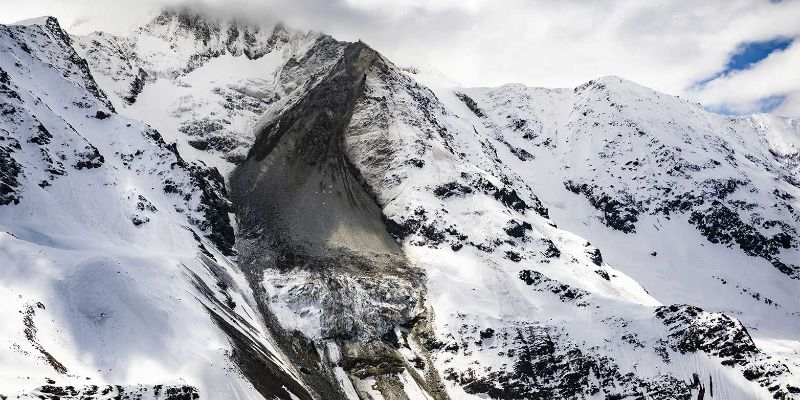What ETH glacier researchers know about the collapse of the Birch Glacier
In brief
- In terms of the volume and the extent of the damage caused, the collapse of the Birch Glacier is unprecedented for the Swiss Alps.
- Several rockfalls from the Kleine Nesthorn Mountain above the Birch Glacier played an important role. The sliding of an entire slope section gave the final impetus for the glacier collapse. The details are still being investigated.
- The accumulated rock debris increased the pressure on the glacier ice, contributing to the destabilisation of the Birch Glacier - as meltwater formed both at the base and inside the glacier.
- The updated fact sheet contains new information on the behaviour of the glacier, the role of permafrost and possible links to climate
A collapse of the magnitude of the Birch Glacier, which buried the village of Blatten in Valais on Wednesday, is unprecedented for the Swiss Alps. While a rock-ice collapse at Piz Scerscen in April 2024 did cause a similar amount of ice and debris to fall – estimated at eight to nine million cubic metres – as in the Lötschental valley this week, the collapse in the Engadine region did not result in as much damage as in Blatten.
Daniel Farinotti, Professor of Glaciology at ETH Zurich and the Federal Institute for Forest, Snow and Landscape Research (WSL), asserts that the exact causes of Wednesday’s glacier collapse are far from fully understood. In particular, Professor Farinotti states, it is not yet conclusive whether external factors or primarily reactions inside the glacier itself were decisive in ultimately triggering the collapse.
However, since authorities and researchers have been monitoring the glacier for years, there are clear indications that several rock avalanches and terrain movements on Kleines Nesthorn, the mountain above the glacier, were the primary cause behind the glacier’s collapse.
“We know there were already several rock avalanches before the collapse on Wednesday and that rock debris accumulated on the glacier as a result,” says Professor Farinotti, who has been working with ETH and WSL researchers Matthias Huss and Mylène Jacquemart to compile a factsheet that summarises the current state of knowledge from the perspective of glacier research.
“Our aim is to use this data and our available knowledge to support the authorities, who are doing incredible work in extremely difficult circumstances to maintain an overview of the conditions and improve the situation for the people,” explains Professor Farinotti.
A combination of factors led to the collapse
The accumulated rock debris – estimated by the authorities to amount to 9 million tonnes – increased the pressure on the glacier ice and encouraged the formation of meltwater at the base of the glacier. It is estimated that around 10 millimetres of water formed in the glacier in this way. The rising water pressure, together with the incoming rain and the unstable mountain terrain, destabilised the Birchgletscher and accelerated the flow of ice. As a result, the glacier moved deeper and deeper down the valley until it finally collapsed.
The unusual valley movement of the Birch Glacier had already attracted the attention of researchers and authorities some time ago, prompting closer observation of the movements around Kleines Nesthorn.
With glaciers generally retreating throughout Switzerland, ETH researchers – currently documenting glacier developments within the GLAMOS glacier monitoring network together with the universities of Fribourg and Zurich – noticed that the front of the glacier in the lower part of the Birch Glacier had advanced by approximately 50 metres since 2019.
Observational data also shows that ice thickness at the glacier snout advanced by up to 20 metres between 2017 and 2023, while the upper reaches of the glacier thinned. This increase is due in part to the rock debris resting on the glacier, as this prevented the ice from melting at the surface.
Comparison with other ice and rock collapses
Kleines Nesthorn and the Birch Glacier have been under close observation since the 1990s, when two snow and ice avalanches affected part of the local infrastructure. Part of the Birch Glacier’s development can also be seen in satellite images.
In the updated fact sheet, the researchers state that a direct link between the permafrost degradation and the collapse of the Birch Glacier has not yet been conclusively established without further investigations. However, it is considered likely that rising temperatures have contributed to the thawing of the subsoil, an increase in rockfalls, and – paradoxically – the unusual advance of the glacier.
The glacier collapse above Blatten has some parallels to the rock avalanche at Piz Cengalo in 2017, when around three million cubic metres of rock fell onto a small glacier, causing it to be partly swept away and triggering a flow of debris. This caused severe damage to infrastructure in the village of Bondo. Eight people were killed during the incident.
On 2 September 2002, the Kolka–Karmadon glacier collapsed in the Russian Caucasus, resulting in 100 million cubic metres of ice travelling up to 19 kilometres down the valley. The avalanche buried the village of Nizhniy Karmadon and claimed 125 lives.
In Valais, systematic surveillance and the precautionary evacuation of the village of Blatten largely prevented such a tragedy. "Our thoughts remain with the community of Blatten and with the incredible work carried out on the ground by the local authorities and other actors," concludes Daniel Farinotti.
